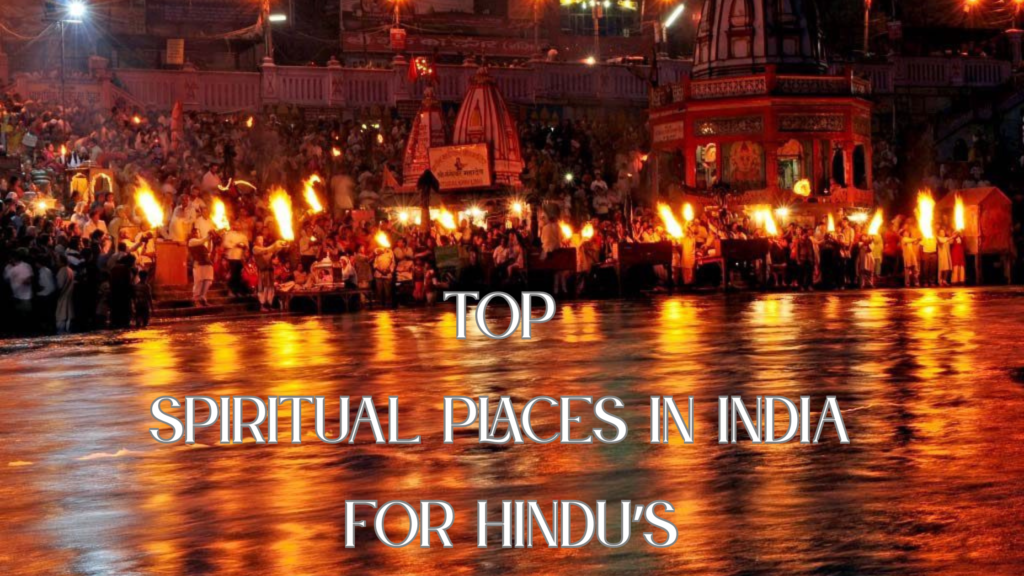India, a land of diverse faiths and deep-rooted traditions, is dotted with spiritual landmarks that hold immense significance in Hinduism. From snow-covered shrines in the Himalayas to sacred ghats of the south, these spiritual destinations are more than just places of worship—they are epicenters of culture, peace, and ancient heritage.
This blog takes you on a journey through the top 15 spiritual places in India that every Hindu should visit at least once in a lifetime.
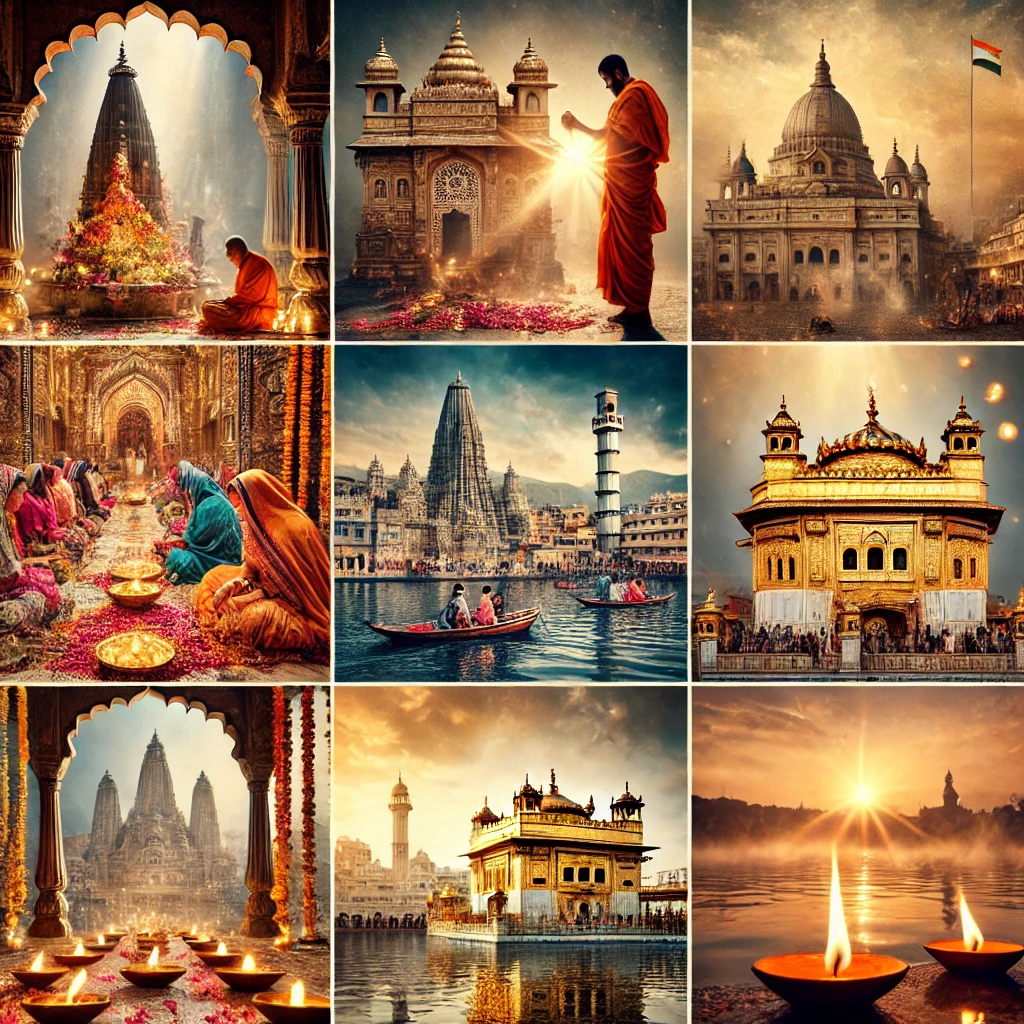
1. Varanasi, Uttar Pradesh – The Eternal City
Historical & Spiritual Significance:
Varanasi, also known as Kashi or Banaras, is considered the most sacred city for Hindus. Believed to be established by Lord Shiva over 3,000 years ago, it symbolizes the eternal cycle of life and death. According to Hindu scriptures, dying in Varanasi and having one’s ashes scattered in the Ganges ensures liberation from rebirth (moksha).
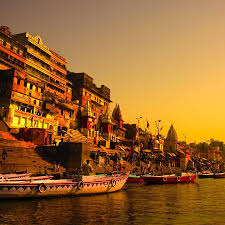
Significance: One of the oldest inhabited cities in the world and considered the spiritual capital of India.
Highlights:
- Situated on the banks of the Ganga, Varanasi is where life and death meet. Hindus believe dying here grants moksha (liberation).
- Famous ghats: Dashashwamedh, Manikarnika, Assi
- The Ganga Aarti at Dashashwamedh Ghat is a divine spectacle.
- Important temples: Kashi Vishwanath Temple, Sankat Mochan Hanuman Temple
Best Time to Visit: October to March
How to Reach: Well connected by rail, road, and air via Lal Bahadur Shastri Airport.
Additional Insights:
- Home to over 2,000 temples, including the sacred Kashi Vishwanath Temple, one of the 12 Jyotirlingas.
- It is a center for learning, music, and Sanskrit education, having been patronized by saints like Tulsidas and Kabir.
Things to Do:
- Witness the Ganga Aarti at sunset.
- Take a boat ride at dawn to explore the ghats.
- Visit Sarnath, where Buddha gave his first sermon.
Do’s and Don’ts:
- Do respect the customs during cremation ceremonies on the ghats.
- Don’t take photos of the cremation sites.
2. Rameswaram, Tamil Nadu – The Southern Gateway of Moksha
Historical & Spiritual Significance:
Located on Pamban Island, Rameswaram is linked to the Ramayana. It is where Lord Rama worshipped Lord Shiva after returning victorious from Lanka. The main temple, Ramanathaswamy, houses one of the 12 Jyotirlingas and is an essential part of the Char Dham Yatra.

Significance: One of the Char Dham and 12 Jyotirlinga sites; associated with Lord Rama.
Highlights:
- Believed to be the site where Lord Rama built the Ram Setu to Lanka.
- The Ramanathaswamy Temple is famed for its long corridors and 22 holy water wells (Theerthams).
- Spiritual cleansing by bathing in Agni Theertham.
Best Time to Visit: October to April
How to Reach: Nearest airport is Madurai (170 km); well connected by rail and road.
Additional Insights:
- The temple’s architecture features 1,200 intricately carved pillars and the longest corridor in any Hindu temple.
- Believers bathe in 22 Theerthams before entering the sanctum.
Things to Do:
- Visit the ancient floating stone bridge area (believed to be Ram Setu).
- Explore Dhanushkodi Beach and the ghost town destroyed in the 1964 cyclone.
Do’s and Don’ts:
- Dress conservatively.
- Do not enter Theerthams without proper guidance.
3. Kedarnath, Uttarakhand – The Remote Jyotirlinga
Historical & Spiritual Significance:
According to legend, the Kedarnath Temple was built by the Pandavas and later revived by Adi Shankaracharya. It is perched in the Himalayas at an altitude of over 11,700 feet and is accessible only for six months due to extreme weather.
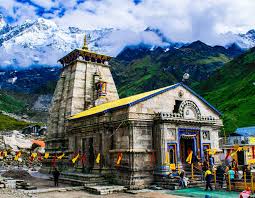
Significance: One of the Char Dham and 12 Jyotirlingas.
Highlights:
- Located in the Garhwal Himalayas at 11,755 feet, this shrine is believed to have been built by the Pandavas.
- Open only from April/May to October due to heavy snowfall.
- Requires a trek of 16 km from Gaurikund or a helicopter ride.
Best Time to Visit: May to June, September to October
How to Reach: Helicopter services from Phata or trek from Sonprayag/Gaurikund.
Additional Insights:
- The stone temple has survived major floods and earthquakes, considered miraculous by many.
- Pilgrims often combine Kedarnath with the Panch Kedar pilgrimage (Tungnath, Rudranath, Madhyamaheshwar, Kalpeshwar).
Things to Do:
- Attend the early morning Rudrabhishek pooja.
- Trek to Chorabari Tal (Gandhi Sarovar).
Do’s and Don’ts:
- Acclimatize before the trek.
- Avoid overexertion at high altitudes.
4. Dwarka, Gujarat – Krishna’s Kingdom
Historical & Spiritual Significance:
As per ancient texts, Dwarka was the capital of Lord Krishna’s kingdom. The current Dwarkadhish Temple was built around 2,200 years ago and has undergone several restorations.

Significance: Dwarka is considered the ancient kingdom of Lord Krishna and is part of the Char Dham.
Highlights:
- Visit the Dwarkadhish Temple, a 5-storey shrine dedicated to Lord Krishna.
- Rukmini Devi Temple, Bet Dwarka, and Nageshwar Jyotirlinga also hold importance.
- The city is steeped in stories from the Mahabharata.
Best Time to Visit: November to February
How to Reach: Nearest airport is Jamnagar (130 km); connected by road and train.
Additional Insights:
- Archaeological underwater studies have found evidence of ancient city ruins submerged in the Arabian Sea.
- The temple is built on the banks of the Gomti River.
Things to Do:
- Visit Sudama Setu, a suspension bridge.
- Perform rituals at Gomti Ghat and take a holy dip.
Do’s and Don’ts:
- Carry ID proof as security is strict.
- Avoid visiting the temple during peak darshan hours without online booking.
5. Badrinath, Uttarakhand – Vishnu’s Mountain Abode
Historical & Spiritual Significance:
Dedicated to Lord Vishnu, this temple is one of the most visited religious sites in India. It is part of both the Char Dham and the Chota Char Dham circuits. According to mythology, Vishnu meditated here while Goddess Lakshmi sheltered him as a tree.
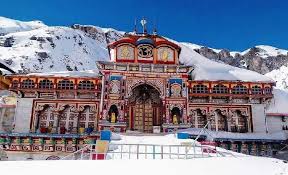
Significance: A revered Char Dham site and part of the Chota Char Dham Yatra in Uttarakhand.
Highlights:
- Located at 10,200 feet, nestled in the Garhwal Himalayas.
- The Badrinath Temple, dedicated to Lord Vishnu, is flanked by Nar and Narayan mountains.
- The Tapt Kund hot spring is believed to have healing powers.
Best Time to Visit: May to June, September to October
How to Reach: Accessible via road from Haridwar/Rishikesh; nearest airport is Jolly Grant Airport, Dehradun.
Additional Insights:
- Adi Shankaracharya rediscovered the temple site in the 9th century AD.
- The idol of Badrinarayan is made of black stone (saligram) and faces west.
Things to Do:
- Take a dip in Tapt Kund before darshan.
- Visit Mana village, the last village before the Indo-Tibetan border.
Do’s and Don’ts:
- Photography inside the temple is prohibited.
- Don’t forget warm clothing—even summers are cold.
6. Puri, Odisha – The Seat of Lord Jagannath
Historical & Spiritual Significance:
The Jagannath Temple is dedicated to Lord Jagannath (a form of Krishna). It is renowned for the Rath Yatra festival, where deities are paraded in chariots to the Gundicha Temple.
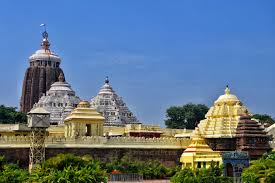
Significance: Famous for the Jagannath Temple, it is a key Char Dham site and known for the grand Rath Yatra.
Highlights:
- Dedicated to Lord Jagannath, an avatar of Lord Vishnu.
- Non-Hindus are not allowed inside the temple, but can view from nearby platforms.
- Visit Puri beach, Chilika Lake, and Konark Sun Temple nearby.
Best Time to Visit: November to February
How to Reach: Nearest airport is Bhubaneswar (60 km); well connected by train.
Additional Insights:
- The flag atop the temple always flutters in the opposite direction of the wind.
- The kitchen is the largest in the world and serves Mahaprasad to thousands daily.
Things to Do:
- Attend Rath Yatra (June–July).
- Explore the Puri-Konark marine drive.
Do’s and Don’ts:
- Non-Hindus are not allowed inside the temple.
- Maintain decorum during temple rituals.
7. Ayodhya, Uttar Pradesh – Ram Janmabhoomi
Historical & Spiritual Significance:
Ayodhya is believed to be the birthplace of Lord Rama, the seventh avatar of Vishnu. With the inauguration of the Ram Mandir in 2024, Ayodhya has become one of the most sought-after pilgrimage destinations.
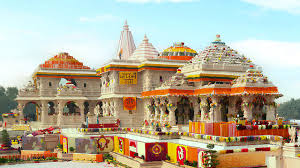
Significance: The sacred city where Lord Rama was born.
Highlights:
- Home to the newly built Ram Mandir, inaugurated in January 2024.
- Other important spots: Hanuman Garhi, Kanak Bhawan, and Saryu Ghat.
- The city has gained immense attention and religious tourism post-temple inauguration.
Best Time to Visit: October to March
How to Reach: Ayodhya is connected via rail and road; nearest airport is Ayodhya International Airport.
Additional Insights:
- The temple architecture reflects traditional Nagara style.
- The city is mentioned in the Ramayana, Skanda Purana, and Valmiki’s works.
Things to Do:
- Attend the evening Aarti on Saryu River.
- Visit Treta ke Thakur Temple and Hanuman Garhi.
Do’s and Don’ts:
- Photography may be restricted in inner sanctums.
- Respect religious sentiments during temple visits.
8. Tirupati, Andhra Pradesh – Venkateswara’s Hill
Historical & Spiritual Significance:
Tirumala Venkateswara Temple is considered one of the richest and most visited temples globally. Devotees believe Lord Vishnu incarnated here to save mankind from the trials of Kali Yuga.
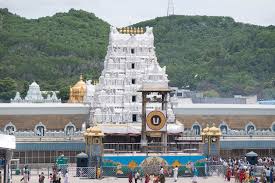
Significance: Home to Sri Venkateswara Swamy Temple, one of the most visited pilgrimage sites.
Highlights:
- The temple is known for its architecture and the ritual of hair tonsuring as a form of devotion.
- The laddu prasadam is iconic and considered sacred.
- The seven hills of Tirumala are believed to represent the serpent Adisesha.
Best Time to Visit: September to March
How to Reach: Tirupati has a domestic airport and is well connected by rail and road.
Additional Insights:
- It receives donations exceeding ₹1,000 crores annually.
- The idol is believed to be self-manifested (Swayambhu).
Things to Do:
- Witness Suprabhatam Seva in early morning.
- Visit nearby Padmavati Temple and Akasa Ganga Teertham.
Do’s and Don’ts:
- Book darshan tickets online in advance.
- Avoid mobile phones and cameras on the premises.
9. Kanchipuram, Tamil Nadu – A Temple City
Historical & Spiritual Significance:
Known as one of the Sapta Puri (seven moksha-puris), Kanchipuram is home to more than 100 ancient temples built during the Pallava, Chola, and Vijayanagara dynasties.
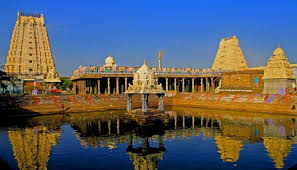
Significance: One of the seven Moksha-puris; important for Shaivism and Vaishnavism.
Highlights:
- Renowned temples include Kanchi Kamakshi Temple, Ekambareswarar Temple, and Varadaraja Perumal Temple.
- The town is also famous for Kanchipuram silk sarees.
Best Time to Visit: October to March
How to Reach: Nearest airport is Chennai (75 km); also accessible by train and bus.
Additional Insights:
- The Kanchi Kamakshi Temple is a key Shakti Peetha.
- The town was a center for education and Tamil culture in ancient India.
Things to Do:
- Visit silk weaving centers and purchase authentic Kanjivaram sarees.
- Attend the Brahmotsavam festival.
Do’s and Don’ts:
- Cover shoulders and legs while entering temples.
- Avoid bargaining at temple premises.
10. Ujjain, Madhya Pradesh – Shiva’s Sacred Soil
Historical & Spiritual Significance:
Situated on the banks of the Shipra River, Ujjain is one of the seven sacred cities and hosts the Kumbh Mela. It is the site of the Mahakaleshwar Temple, where the Shiva Linga is believed to be self-manifested.
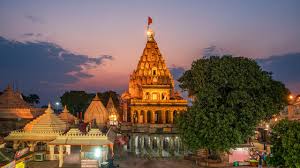
Significance: Site of the Mahakaleshwar Jyotirlinga and one of the seven sacred Sapta Puris.
Highlights:
- The Bhasma Aarti at Mahakaleshwar Temple is a unique ritual performed daily.
- Ujjain hosts the Kumbh Mela every 12 years.
- Also visit Kal Bhairav Temple, Ram Ghat, and Harsiddhi Temple.
Best Time to Visit: October to March
How to Reach: Nearest airport is Indore (55 km); well connected by train.
Additional Insights:
- The Bhasma Aarti involves the use of sacred ash and is performed at 4 am.
- Ujjain is associated with the Mahabharata era and ancient astronomical sciences.
Things to Do:
- Visit the Kal Bhairav Temple.
- Explore the Jantar Mantar (Vedh Shala), one of India’s ancient observatories.
Do’s and Don’ts:
- Queue up early for Bhasma Aarti.
- Maintain silence in the sanctum.
11. Amarnath, Jammu & Kashmir – The Ice Lingam of Lord Shiva
Historical & Spiritual Significance:
Amarnath Cave is one of the holiest shrines dedicated to Lord Shiva. It is famous for the naturally occurring ice Shivling, which waxes and wanes with the moon cycle. As per mythology, Lord Shiva narrated the secret of immortality (Amar Katha) to Goddess Parvati in this very cave, unaware that a pair of pigeons overheard the tale and became immortal.
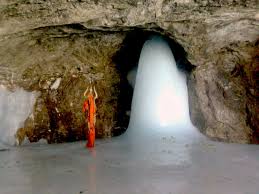
Significance: Center of Tamil spirituality and home to the famous Meenakshi Amman Temple.
Highlights:
- The temple complex is known for its intricate architecture and 14 gopurams.
- The city hosts the Meenakshi Tirukalyanam Festival in April-May.
- Visit also Thirumalai Nayakkar Palace and Alagar Koil.
Best Time to Visit: October to February
Additional Insights:
- The cave is situated at an altitude of 3,888 meters and is accessible only during July–August for the Amarnath Yatra.
- The site is one of the 51 Shakti Peethas and is guarded by Indian armed forces for pilgrim safety.
How to Reach:
- Nearest Airport: Srinagar (90 km)
- Trekking Routes: From Pahalgam (36 km trek) or Baltal (14 km trek)
- Helicopter services available from Baltal or Pahalgam during Yatra.
Things to Do:
- Trek through the beautiful yet challenging Himalayan paths.
- Visit the Panchtarni camping site and Sheshnag Lake en route.
Do’s and Don’ts:
- Do undergo a health check-up before registering for the Yatra.
- Don’t litter or harm the fragile Himalayan ecosystem.
12. Madurai, Tamil Nadu – Abode of Meenakshi Devi
Historical & Spiritual Significance:
Madurai is one of the oldest living cities in India, centered around the Meenakshi Amman Temple, which dates back to the 6th century BCE. According to legend, Goddess Parvati appeared as Meenakshi and ruled Madurai, marrying Lord Sundareswarar (Shiva). Their divine wedding is celebrated annually as the Meenakshi Thirukalyanam.
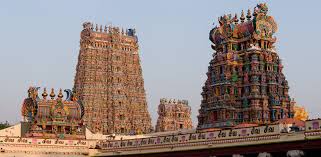
Significance: Sacred cave shrine where a natural Shiva Linga forms from ice.
Highlights:
- A challenging trek, open only for a few weeks in July–August.
- The Amarnath Yatra draws thousands of devotees annually.
- Pilgrims often trek from Pahalgam or Baltal with government-arranged facilities.
Best Time to Visit: July to August (during yatra)
Additional Insights:
- The temple complex spans over 14 acres and is adorned with 14 gopurams, the tallest being over 170 feet.
- It receives millions of devotees every year and is a shining example of Dravidian architecture.
How to Reach:
- Nearest Airport: Madurai International Airport (12 km)
- Nearest Railway Station: Madurai Junction
- Well connected by road to all parts of Tamil Nadu
Things to Do:
- Witness the temple’s night ceremony (Palliarai) where deities are ritually put to sleep.
- Explore the 1000 Pillar Hall, a museum showcasing art and relics.
Do’s and Don’ts:
- Dress conservatively and follow temple customs.
- Avoid photography inside the sanctum sanctorum.
13. Sabarimala, Kerala – Pilgrimage of Ayyappa Devotees
Historical & Spiritual Significance:
Sabarimala is dedicated to Lord Ayyappa, believed to be the son of Shiva and Mohini (an incarnation of Vishnu). It is one of the largest annual pilgrimage destinations in the world, drawing millions of devotees during Mandala (Nov–Dec) and Makaravilakku (Jan) seasons.

Significance: Home to the Nataraja Temple, dedicated to Lord Shiva’s cosmic dance.
Highlights:
- The temple’s architecture symbolizes the connection between science, art, and spirituality.
- The Chidambara Rahasyam (secret of Chidambaram) is an invisible symbol of formless divinity.
- It’s one of the Pancha Bhoota Sthalas representing ‘space’.
Best Time to Visit: October to March
Additional Insights:
- Devotees observe 41 days of strict vratham (penance), including celibacy and abstinence from alcohol and meat.
- The trek to the temple through dense forests symbolizes spiritual awakening.
How to Reach:
- Nearest Railway Station: Chengannur (93 km)
- Nearest Airport: Kochi or Thiruvananthapuram
- Last 5 km is a forest trek from Pamba
Things to Do:
- Participate in the early morning darshan.
- Trek through the Pathinettampadi (18 sacred steps) reserved for those carrying the irumudi.
Do’s and Don’ts:
- Only men and women aged above 50 or below 10 are allowed.
- Do not break the 41-day vow rules.
14. Chidambaram, Tamil Nadu – Dance of the Cosmos
Historical & Spiritual Significance:
Chidambaram Temple is unique in that it is dedicated to Nataraja, the cosmic dancing form of Lord Shiva. It is one of the Pancha Bhoota Sthalams, representing the element Akasha (ether). According to legend, Shiva performed the Ananda Tandava (Dance of Bliss) here to defeat arrogance and ego.
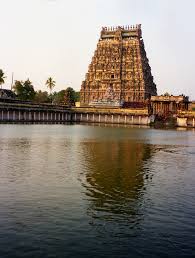
Significance: Dedicated to Lord Ayyappa, this is one of the largest annual pilgrimages in the world.
Highlights:
- Pilgrims undertake a 41-day penance before visiting the shrine.
- Women of menstruating age (10-50) traditionally do not visit the temple.
- The journey to Sannidhanam through the forests symbolizes inner cleansing.
Best Time to Visit: November to January (Mandala Season)
Additional Insights:
- The temple architecture reflects a blend of spirituality and science; the deity is represented by both form and formlessness.
- It is the only major Shiva temple with a deity in a dancing pose.
How to Reach:
- Nearest Airport: Chennai (235 km)
- Nearest Railway Station: Chidambaram Station
- Connected by road to nearby cities like Pondicherry and Thanjavur
Things to Do:
- Attend the Margazhi Tiruvadirai festival in December.
- Watch the priests perform the daily dance rituals.
Do’s and Don’ts:
- Keep silence and respect during rituals.
- Do not touch temple idols or use flash photography.
15. Srikalahasti, Andhra Pradesh – The Vayu Lingam Shrine
Historical & Spiritual Significance:
Located on the banks of the Swarnamukhi River, Srikalahasti Temple is another of the Pancha Bhoota Sthalams, representing Vayu (air). According to legend, Vayu performed penance here to please Lord Shiva. It is also famous for the Rahu-Ketu Dosha Nivarana Puja, attracting thousands facing astrological hardships.
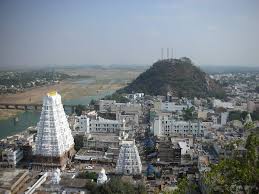
Significance: Part of the Pancha Bhoota Sthalas, it represents the element of air (Vayu).
Highlights:
- Known for its powerful Rahu-Ketu pooja for planetary peace.
- The temple is also associated with the story of Kannappa, the devoted hunter.
- Located near Tirupati, it’s a good stop for extended pilgrims.
Best Time to Visit: October to February
Additional Insights:
- The temple tower (gopuram) is 120 feet high and showcases stunning South Indian architecture.
- The main deity is untouched by human hands—even during Abhishekam, the priest performs rituals from a distance.
How to Reach:
- Nearest Airport: Tirupati (26 km)
- Nearest Railway Station: Srikalahasti Station
- Well connected by road from Tirupati
Things to Do:
- Perform the Rahu-Ketu Pooja (must be done without food).
- Visit the inner sanctum where the lamp continues to flicker despite lack of air flow.
Do’s and Don’ts:
- Avoid wearing black during pooja rituals.
- Do not eat non-vegetarian food or consume alcohol the day before the puja.
Final Thoughts About Top 15 Spiritual Places in India
These 15 spiritual destinations reflect the vast spiritual heritage of India, showcasing a blend of mythology, architecture, and divine energy. Whether you’re seeking moksha, inner peace, or simply a reconnection with your roots, these places offer something profound for every Hindu soul.
FAQ: Top 15 Spiritual Places in India
Q1. What is the best time to visit spiritual destinations in India?
A: Most temples are best visited between October to March, though specific festivals like Kumbh Mela, Rath Yatra, or Makaravilakku also attract massive footfall.
Q2. Can foreigners visit these temples?
A: Some temples like Jagannath Puri restrict entry to non-Hindus. Always check the specific temple guidelines.
Q3. Do I need to observe any fast or ritual before visiting?
A: For temples like Sabarimala or Kedarnath, rituals and fasting (vrat) are often observed. Read official temple websites for accurate info.
Q4. Are these places safe for solo women travelers?
A: Yes, with basic precautions. Temples like Madurai, Tirupati, and Varanasi are particularly women-friendly with dedicated queues and facilities.
Q5. Can children and elderly people visit high-altitude temples like Kedarnath or Amarnath?
A: Consult a doctor before planning. These places involve rigorous treks and extreme weather conditions.
For more such amazing places in India visit Incredible India.
Know more about Spiritual Places in India follow Popnewsblend.
Read more about Top 10 Mysterious & Magical Temples in India.
Read more about 13 Jyotirlingas of Lord Shiva.
Read more about Top 10 Temples in South India One Should Visit.

Hi, I’m Prashant Jain — a curious soul, storyteller, and content creator at heart.I’ve always been drawn to the world of entertainment, travel, sports, health & lifestyle — not just as a writer, but as someone who genuinely lives these experiences. Whether I’m binge-watching the latest OTT series, exploring offbeat spiritual destinations in India, or diving deep into wellness routines and cricket match insights, I love sharing what I discover with like-minded readers.
PopNewsBlend is my way of blending personal journeys with meaningful stories — ones that inform, inspire, and keep you ahead of the curve. Everything I write comes from real observations, hands-on experiences, and a deep passion for understanding the world around us.
Discover more from Popnewsblend
Subscribe to get the latest posts sent to your email.

